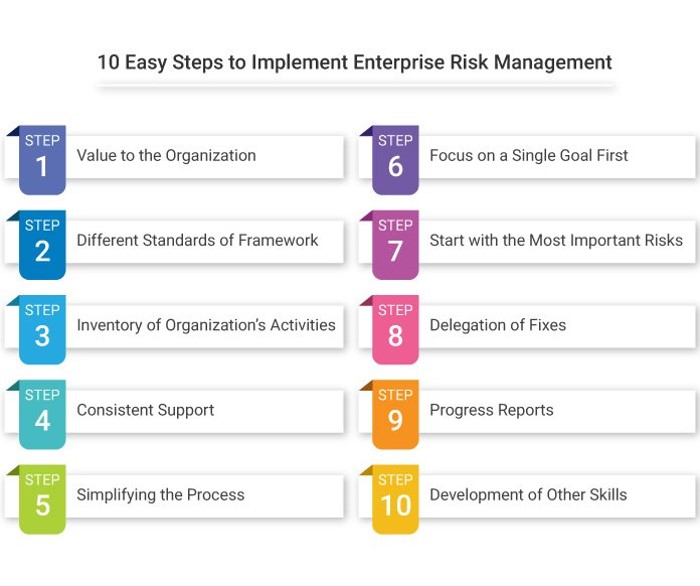
All this while, companies have been dealing with risk in a very reactive manner. Instead of preparing for any risks to their company, projects, and other stakeholders, they respond to risks only when they face them. This ad hoc method of dealing with risk is extremely irresponsible and can affect the health of the company.

According to the 2010 Report on the Current State of Enterprise Risk Oversight: 2nd Edition, it was noted that all existing risk management processes have been relatively immature and ad hoc. This is the condition in the finance industry, but there are risks that need to be addressed in organizations regardless of industry. The retail sector, agriculture sector, and IT sector are some of the many industries that also face many risks. Here the development of enterprise risk management solutions is at an even more immature stage.
At this stage, the value derived from an enterprise risk management solution is very limited. There is no implementation of a solution with this crude method. What ends up happening is that companies are generally just left with a list of risks and virtually no means on how to mitigate or manage them. The employees have not been trained on how to properly deal with risk and the entire risk management process becomes mismanaged and serves no purpose.
Over the last few years though, various institutions have realized this flaw in their processes and are working on improving their operations. An enterprise risk management solution can help with that. It helps in streamlining various processes in the company to come up with a clear idea of how to properly identify and assess risks. Then the ERM comes up with innovative solutions to manage and mitigate these risks. This makes all the projects go on smoothly and the company does not have to constantly worry about the risks they might face because they are already preemptively addressing them.
So the next question to ask would be, what exactly is an enterprise risk management system?
What is Enterprise Risk Management?
There are a lot of aspects to creating a successful enterprise risk management solution. An ERM can be defined as a structure created for an organization to continuously improve its capability of managing risk in a constantly changing business environment. It is a discipline and culture embedded in any organization that helps them effectively manage and adapt to many risks.
Enterprise risk management is an ongoing process. It is applied in the form of strategies across all the departments in a company. The enterprise risk management system is created to identify potential threats that could affect the capabilities and functioning of an organization. The ERM then manages the risk within the company’s risk appetite. This ends up providing stakeholders some level of certainty that will aid them in achieving their business objectives.
Enterprise risk management is a crucial part of all organizational processes and also the decision-making in a company.
The Importance of Enterprise Risk Management
There are a lot of ongoing issues that organizations across any industry can face. Business owners have realized that their world is constantly changing, which will impact the business fundamentals. The CEO and board members of organizations need to be ahead of the curve and anticipate these changes so that they can be successful in their ventures.
This is where enterprise risk management comes into play. Risk management is mainly about securing a company’s place to ensure the success of its operations in the future. This will help organizations maintain their foothold in the marketplace.
Companies need to be fully aware of all the strategic uncertainties that they might have to face. This requires a deep level of understanding about the assumptions they make about their strategies, after which they can monitor the changes to the business environment to see whether or not their assumptions stay true in the future.
The main question that enterprise risk management answers is: Do we have the processes in place to identify and manage future risks good enough?
The Need for Enterprise Risk Management
A recent study has shown that about 69% of business executives are not confident about their current risk management practices and policies. They do not know if their current policies will be enough to meet future needs. This only emphasizes the need for ERM in this challenging business climate.
Organizations need to take a more strategic outlook to apply to their operational risks. This means that there is a need for an extended view of the entire organization to monitor all existing relationships between departments, team members, and employees. An enterprise-wide view will help expose if any component of the organization is missing or at risk at any given point in time.
Eventually, all organizations will face a crisis that will test the business operations of the company. It doesn’t matter how effective your enterprise risk management solution is because it won’t be able to prevent this from occurring. What an effective enterprise risk management solution can do for any organization is to help them minimize the damage. It will help companies brace for the speed, the duration, and the severity of the impact. An enterprise risk management system creates the organization’s response readiness to all risks.
Key Drivers of Enterprise Risk Management
Risk Management Strategy
The first step before starting with all the concepts that come with risk management such as identification, analysis, and mitigation, is to decide on the risk management priorities of the organization.
Along with the priorities, companies also need to gain a better understanding of the following:
- Their business objective
- The approach they want to take toward risk management
- The risk governance structure they want to create
- Size and complexity of their business model
Companies should also have an assessment of all the required roles that need to be assigned for effective risk management. This will help in giving out responsibility both in-house and when outsourced.
Risk Ownership
The person who executes risk responses is often the one who gets assigned ownership of the risk. This is not just about accountability. There are two aspects to risk management:
- Head of risk management function: His role is to communicate, coordinate, and administer all the risk management policies and processes of the company. He is also in charge of identifying and mitigating material risks by the risk owners
- Risk owner: He is the one who is actually in charge of managing risks and reports to the head responsible for a risk management function in an organization
The risk owner should not be held responsible for monitoring the effectiveness of the risk response. His job is to make sure the risk response is adjusted within the risk appetite of the domain he is in charge of.
Risk Management Competency
There are four types of responsibilities that come with risk management, which are:
- People in charge of risk governance
- People in charge of risk management
- People in charge of risk responses
- People in charge of reporting how effective the risk responses were
All four profiles in risk management need to be trained appropriately so that they have the right skill set and experience to perform their job roles effectively.
Decision Making
Making mistakes in the strategy phase itself can have a big impact on how effective the risk management process is. A lot of risk management efforts are usually focused on risks during and after the implementation of ERM but forget the mistakes and risks in the strategic choices made beforehand.
This is why risk management should be applied while the decision-making stage is underway so that all employees have a thorough understanding of the risks that come with each decision they make.
Daily Operations
The risk management platform should be enterprise-wide. This means it has to include all day-to-day operations as well to ensure effective and efficient execution. In fact, risk management procedures and policies should become a part of training for all new employees so that they join the company with appropriate risk culture. 66% of executives believe that the biggest priority for financial institutions with an enterprise risk management solution is the collaboration between business units and the risk management function.
Continuous Monitoring
Depending on the size and functions of the business organizations, there should be processes in place that are continuously monitoring the performance of the enterprise risk management system. This will make sure reports on risk responses are going to risk owners and people in charge of risk governance in a timely manner.
This is a very important key driver because it ensures that the company stays within their risk appetite and is always in line with all the regulatory policies.
Periodic Monitoring
The biggest challenge for companies when it comes to compliance is “continuing regulatory change”. To ensure compliance with all the policies and procedures, there needs to be an internal audit with enough resources and skills that monitors all processes periodically. The internal audit unit needs to have direct access to the Audit Committee to ensure everything is done above board.
There has to be a collaboration between the internal audit unit and the risk management unit. It is very important for the internal audit unit to understand all key risk areas to improve their reviews. The risk management unit needs to work with the internal audit department to make sure that all the necessary actions are being taken on time and their accuracy.
Culture and Board Oversight
There has to be a proper risk culture created across the organization to ensure the effective implementation of risk management. The upper management and the board of directors need to work together to create different guidelines so that there is a strong risk culture environment created in the company.
How to Implement Enterprise Risk Management?
1. Value to the Organization
When organizations implement an enterprise risk management solution, they need to make sure that it adds value to their business. It is difficult to measure the traditional methods of ROI when it comes to an ERM system. This is why a lot of businesses consider these four factors before implementation:
- Shareholder value
- Risk mitigation
- Solo elimination
- Process consolidation
Once the ERM system they have selected meets these categories, they can begin the implementation process. The solution needs to add value to the organization as well, which needs to be determined by the management. The first step to that is understanding what risks the organization needs to protect and how the ERM system will help them in doing so. It also needs to be aligned with the business values of the organization as well as the objectives of the company.
According to a recent study, the top ERM program priorities for a lot of financial institutions when it comes to what they look for in the system are:
- How the system manages to collaborate with both the business functions as well as the risk management function (66%)
- How the system can handle the increase in requirements and expectations (61%)
- How well the ERM system can embed risk culture in the organization (55%)
2. Different Standards of Framework
There are multiple ways of managing risk. They also come with specific management guidelines and standards. A lot of risk management practices continue to evolve with the changing environment whereas the risk management standards take a more generalized approach and are similar in a lot of ways.
Organizations can use these standards of the framework to adopt into their enterprise risk management system to ensure a seamless implementation. This framework includes the following processes:
- Identifying risks
- Creating a risk appetite or analyzing the risk
- Evaluating the risk
- Implementation of risk management strategy
- Evaluating how the strategy works
- Constantly monitoring to improve processes and management
3. Inventory of Organization’s Activities
Before the implementation of an enterprise risk management solution, institutions need to take into account the processes they already use to mitigate risk. There are going to be processed already in place to prevent and mitigate certain risks to the organization. These risks need to be acknowledged and leveraged with the enterprise risk management system that is to be implemented.
4. Consistent Support
Implementation of an enterprise risk management solution is going to involve a lot of stakeholders because it affects the overall practices and functions in the organization. The stakeholders need to be involved to accelerate the entire implementation process.
To maintain additional organizational support and advocacy, organizations should also look into working with external sources of support. This includes getting involved with people who are insurance brokers, external auditors, or other consultants.
5. Simplifying the Process
Keep the entire enterprise risk management process simple so that all members of the institution can understand it. This will help in making it easy to comprehend and use. To explain the processes, using simple language that everyone can understand would be the best. Complicated jargon would only confuse the members.
Explain the process using graphics to show a clear path to the employees. The important thing to remember here is to focus on how an enterprise risk management solution will help companies achieve their objectives. This should be the highlight instead of the benefits of the ERM system itself. Keep the training program easy to understand as well so that all the members of teams can learn easily.
6. Focus on a Single Goal First
The full scope of enterprise risk management should not be deciphered in the early stages of implementation. The best way to go about understanding how the solution works for a business is by starting small. Organizations should put their focus on achieving one specific goal first. Then they can focus on the objectives of this goal and the risk management processes involved in realizing this goal.
When companies use controlled implementation at the beginning of their ERM system, it helps them understand their problem areas better. It helps team members see what works and what needs to be improved. It also leads to a higher overall commitment by the employees because once this objective is achieved, they have a platform to build on.
7. Start with the Most Important Risks
Along with starting with a single specific goal to achieve, it is also important for organizations to pick a relevant one. The most important business goals are likely to have big risks in place. Team members should start by tackling the company’s risks that could have the most impact on operations.
Once the risks that could have a big impact on the organization have been identified and mitigated or controlled, the value of the ERM system immediately rises. Then the upper management can discuss the risk appetite of the company. This will help them get a better understanding of which risks can actually be contained or avoided and what business goals they would achieve.
8. Delegation of Fixes
Keep team members in charge of ‘fixing’ risks. The person who holds accountability will be in charge of monitoring the risks as well. Someone who understands the business objective and goal of the project should be in charge. This is because they will be the best people to know the kind of risks the project could have.
The person who is in charge of managing the risk can work alongside other team members as well. This will help in creating a network of interconnected risks. Some risks cannot be easily compartmentalized, so this process helps in creating a well-developed blanket for risk management.
9. Progress Reports
Organizations need to create progress reports regularly. These reports can be used to showcase the impact of the enterprise risk management system. Progress reports can be made in two ways. One way would be to highlight the progress made by the ERM solution. The second way would be to judge the material risk to the organization.
These reports should be included in the normal updates on any project by the risk owners. They should include all the issues faced as well as the outcome. Regular reports should be sent to the upper management as well to help them keep track of how well the system is working alongside other business operations.
10. Development of Other Skills
A thorough understanding of the processes of an enterprise risk management system is not enough. Team members also need to explain its properties, advantages, and processes to other employees and stakeholders. This requires having really good communication skills. Team members need to be able to successfully show how an ERM system can help them achieve their business objectives and keep the enterprise as a whole safe.
Benefits of Enterprise Risk Management
Improved Data Quality
The quality of data that organizations collect is extremely important for their success. Data quality determines the level of insights and strategies they can create. This means good quality data will create better insights for the company, which will lead to better strategies. Better strategies will lead to better outcomes in the future and improve revenue generation.
How does an enterprise risk management platform help with improving the quality of data? An enterprise risk management system is used to optimize all the data available to the organization to assess it for risk. This means the underlying process would be to go through all the data available at hand and enhance the entire process by digitizing it. A manual method of recording all the data available at hand is dated and can affect the quality of data generated. It can also be one of the causes of risks to the organization. Therefore, by digitizing data, companies can optimize it and improve its overall quality.
Cost-Effective Method
Institutions normally have existing methods in which they manage risks. They might not always be as effective or cost-efficient. Large organizations especially, end up giving the responsibility to an entire department or division. This can increase operational costs greatly. When companies employ an enterprise risk management solution, every employee is tasked with the responsibility of risk management. This eliminates the need to spend on resources for an entire department to manage risks, hence cutting down costs.
When companies invest in a good enterprise risk management solution they can also easily reduce the insurance premium for their business. Insurance is usually taken out because companies want to transfer the risk to a third party. If there is a good enterprise risk management solution in place in the organization, this immediately reduces the responsibility of transference of risk to a third party. This means fewer premiums and less cost to the company.
Improved Risk Reporting
Risk reporting can be very flawed when done manually. This leads to reducing the efficiency level at which the organization operates. Inappropriate reporting can also result in hampering the company’s operations.
An enterprise risk management framework removes the possibility of this taking place because it comes with an automated template system for reporting. All the information collected with an ERM system gets streamlined easily across all departments.
An enterprise risk management solution comes with a good in-built structure to improve risk reporting and analysis. The ERM creates regular and standardized reports so that organizations can easily track all enterprise risks. This will help the overall risk mitigation process by providing accurate and reliable data to executives and directors. The data provided will be detailed and varied, covering various aspects of risk such as:
- Status of key risk indicators
- Different Mitigation strategies
- List of all new and emerging risks
This will help all upper management executives understand critical risk areas and also develop a better understanding of the company’s risk appetite and tolerance. This is why, according to a recent study, 44% of organizations have already planned on upgrading their current risk management plan and implementing efficient risk management software.
Helps with Regulatory Compliance
Enterprise risk management processes include identifying and monitoring different controls across the organization. This automatically means that it will consider compliance as well. When companies implement an enterprise risk management system, compliance efforts get reduced.
There are a lot of external agencies that can also benefit from enterprise risk management such as:
- Bond-rating agencies
- Financial statement auditors
- Regulatory examiners
They have started testing, using, and monitoring all data using ERM programs because of this added benefit. It reduces the time and effort they have to take to make sure the organizations remain compliant.
Systematic Risk Management
Now, to the final and most important benefit of implementing an enterprise risk management system: creating a proper and systematic way to handle risk. An effective system in place creates a culture where corporations can handle and manage risk effectively within the organization. This takes place because an enterprise risk management system touches all departments of the organization at all levels, not just the top-level employees.
Due to this approach, a systematic way of risk management is created. All employees become aware of the need for risk management in their daily operations. This ultimately leads to organizations facing a lower exposure to risk that could affect their work in the long run, making enterprise resource management almost necessary for the survival of the organization.
Conclusion
The first step in the successful implementation of any enterprise risk management solution is to understand and create a strategy for your organization. This strategy should have an in-depth understanding of all the assumptions that go with it.
The reality of today’s continuously changing business environment has put enterprise risk management a priority for companies. Organizations are taking a fresh look at the ways in which they have been managing risks, and they have come to understand the importance of an effective ERM process. When companies implement the enterprise risk management system and properly train their employees in IT Governance Certification Courses on how to evaluate and manage risk, they can address their changing business climate better and create a more aware working environment. This will help protect their company against any turbulence they might face in the future.
















